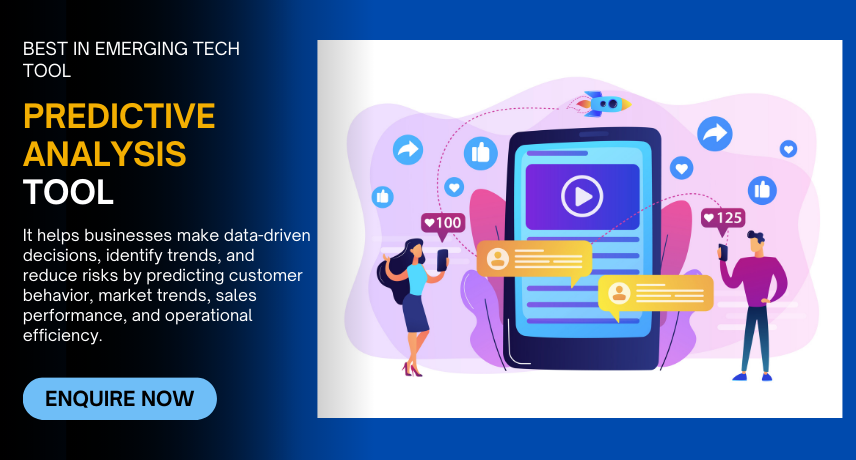Enquiry Form
What is Predictive Analysis Tool?
Predictive Analytics tool uses data, statistical algorithms, and machine learning to forecast future outcomes based on historical data. It helps businesses make data-driven decisions, identify trends, and reduce risks by predicting customer behavior, market trends, sales performance, and operational efficiency.
What are the Best Features of Predictive Analysis Tool?
here Are 15 Key Features of Predictive Analytics Software

Data Integration:
Collects and consolidates data from multiple sources like CRM, ERP, social media, and IoT devices.

Machine Learning & AI:
Uses advanced algorithms to identify patterns and predict future outcomes.

Automated Data Processing:
Cleans, transforms, and organizes data for accurate predictions.

Predictive Modeling:
Builds statistical models to forecast trends, customer behavior, and risks.

Real-Time Analytics:
Provides instant insights and alerts for immediate decision-making.

Data Visualization & Reporting:
Generates easy-to-understand dashboards, charts, and reports.

Trend Analysis:
Identifies emerging trends in sales, marketing, and customer behavior.

Risk Management:
Detects fraud, financial risks, and operational inefficiencies.

Customer Segmentation:
Categorizes customers based on behavior, demographics, and purchase history.

Churn Prediction:
Identifies customers likely to stop using a service and enables retention strategies.

Sales Forecasting:
Predicts revenue, demand, and market fluctuations.

Marketing Optimization:
Enhances ad targeting, campaign performance, and ROI analysis.

Anomaly Detection:
Identifies unusual patterns that may indicate fraud or operational issues.

Prescriptive Analytics:
Suggests the best course of action based on predictive insights.

Cloud & On-Premise Deployment:
Offers flexible deployment options for scalability and security.
Benefits of Predictive Analysis Tool
- Better Decision-Making: Uses data-driven insights to make informed business decisions.
- Improved Forecasting: Accurately predicts trends, customer behavior, and market demand.
- Increased Revenue: Optimizes pricing, sales strategies, and marketing campaigns for higher profitability.
- Risk Management & Fraud Detection: Identifies financial risks, fraud, and security threats in real-time.
- Enhanced Customer Experience: Personalizes recommendations, improves retention, and reduces churn.
- Optimized Marketing Campaigns: Predicts campaign success and refines targeting for better ROI.
- Operational Efficiency: Automates processes, reduces manual errors, and improves productivity.
- Inventory & Supply Chain Optimization: Prevents overstocking or shortages by forecasting demand.
- Competitive Advantage: Helps businesses stay ahead by predicting market changes before they happen.
For Which 5 Industries Is a Predictive Analysis Tool Useful?
Predictive analysis tools are highly versatile and provide data-driven insights that help organizations make informed decisions. While commonly associated with technology and analytics, their applications span multiple industries:

Predictive analysis tools assist in enhancing patient care, predicting disease outbreaks, and optimizing operational efficiency.
- Patient Risk Analysis: Identify patients at high risk for chronic conditions.
- Disease Outbreak Prediction: Monitor trends to forecast epidemics.
- Staffing Optimization: Anticipate staffing needs based on patient inflow.
- Treatment Personalization: Analyze patient data for tailored treatment plans.
- Supply Chain Management: Forecast demand for medical supplies and equipment.

Banks and financial institutions use predictive analysis tools to minimize risks, improve customer experience, and optimize revenue.
- Fraud Detection: Detect unusual transactions in real time.
- Loan Default Prediction: Assess customer creditworthiness accurately.
- Customer Segmentation: Predict customer needs for tailored offers.
- Market Trends Forecasting: Analyze economic data to guide investment strategies.
- Risk Assessment: Identify and mitigate operational or financial risks.

Predictive analysis drives customer engagement and improves inventory and sales strategies.
- Demand Forecasting: Predict product demand to avoid overstock or shortages.
- Customer Behavior Analysis: Personalize recommendations and promotions.
- Dynamic Pricing: Adjust pricing based on market trends and competition.
- Churn Prediction: Identify customers likely to leave and target retention strategies.
- Inventory Optimization: Ensure proper stock levels for popular items.

Predictive analysis tools enhance productivity, reduce downtime, and improve quality control.
- Predictive Maintenance: Anticipate equipment failures to reduce downtime.
- Supply Chain Optimization: Forecast raw material needs and logistics.
- Production Scheduling: Streamline manufacturing schedules based on demand forecasts.
- Quality Control: Detect potential defects during production processes.
- Energy Efficiency: Analyze energy consumption for cost-effective operations.

Energy providers use predictive analysis to improve efficiency, manage resources, and ensure reliable services.
- Demand Forecasting: Predict energy consumption patterns for better distribution.
- Preventative Maintenance: Anticipate equipment failures in power plants or grids.
- Renewable Energy Optimization: Forecast weather patterns for solar and wind energy production.
- Customer Usage Analysis: Provide personalized energy-saving recommendations.
- Load Balancing: Ensure efficient energy distribution during peak and non-peak hours.
How to Choose the Best Predictive Analysis Tool

- Define Your Business Needs: Identify what you want to predict (sales, customer behavior, risks, etc.) and the data sources you'll use.
- Look for Key Features: Ensure the tool offers machine learning, real-time analytics, data visualization, automation, and easy integration.
- Ease of Use: Choose a platform with an intuitive interface, drag-and-drop functionality, and no-code/low-code options if needed.
- Integration Capabilities: Ensure compatibility with your existing CRM, ERP, marketing platforms, and databases.
- Scalability & Performance: Select a tool that can handle increasing data volumes and provide real-time insights as your business grows.
- Security & Compliance: Ensure data privacy standards like GDPR, HIPAA, or PCI-DSS are met.
Predictive Analytics Tool for Data-Driven Decision Making | SID
Unlock the power of data with SID’s Predictive Analytics Tool. Predict trends, improve strategies, and make informed decisions with AI-driven insights for your business.
Latest News
Stay updated with latest industry information






